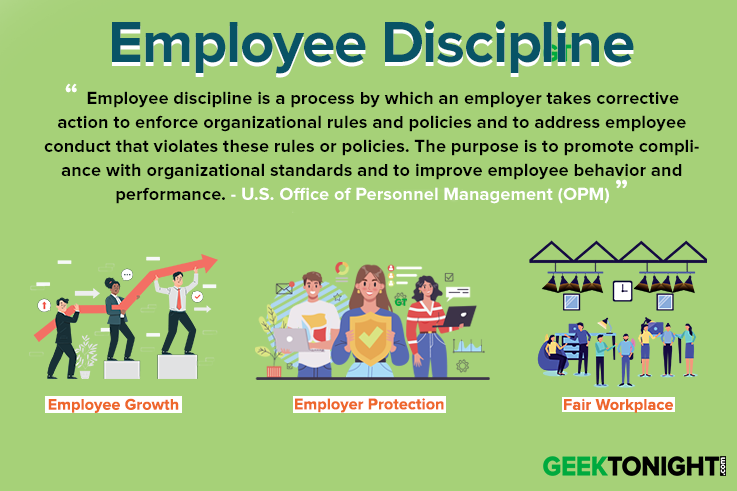What is Employee Discipline?
Discipline means an orderly behaviour to be followed by the individual, team members and groups within an organization to achieve the ultimate objectives. It is true for every organization that in order to maintain harmonious industrial relations strict need for following certain rules and regulations or following a proper code of conduct arises.
This will help an organization to prosper and grow. The purpose of the disciplinary process is that the organizational members/Employees work together as a team to achieve organizational goals.

Table of Content
- 1 What is Employee Discipline?
- 2 What is Discipline?
- 3 Employee Discipline Definition
- 4 Importance of Creating and Following an Employee Discipline Policy
- 5 Types of Discipline
- 6 Causes of Indiscipline
- 6.1 Ineffective leadership or supervision
- 6.2 Lack of proper communication
- 6.3 Favoritism and discrimination
- 6.4 Divide and Rule Policy
- 6.5 Lack of clear rules and regulations
- 6.6 Victimization and bad working conditions
- 6.7 Personal problems of the employees
- 6.8 Improper co-ordination between authority and responsibility
- 7 Objectives of Discipline
- 8 Characteristics of Discipline
What is Discipline?
In other words, we can define discipline as a strength that prompts individuals and groups to study the rules, regulations and procedures which are supposed to be necessary for the successful functioning of an organization. It simply means working, co-operating and behaving in a normal and orderly way, as any responsible person would be expected to do.
Without discipline gradually an organization becomes unprofitable. It is unable to complete its projects in time, meet deadlines or keep promises. Slowly the organization loses goodwill in the market. This impacts the profitability of the business to a huge extent.
Employee Discipline Definition
Employee discipline refers to the range of strategies that employers use to manage employee behavior and performance in the workplace. These strategies can include verbal or written warnings, performance improvement plans, coaching and counseling, and disciplinary measures such as suspension or termination of employment. – Society for Human Resource Management (SHRM)
Employee discipline is the process by which an employer takes corrective action to address employee misconduct or performance issues. This can include verbal or written warnings, suspension, demotion, or termination of employment. – National Council of Nonprofits
Importance of Creating and Following an Employee Discipline Policy
Implementing an effective discipline policy benefits both employees and employers by providing opportunities for professional growth and development, while also serving as a protective measure in cases where termination becomes necessary.
Employee Growth
A successful business helps their employees improve and grow. Through a progressive discipline policy, you can help employees address their mistakes and become greater contributors to the business.
Employer Protection
Some employees fight termination or other disciplinary action, and the conflict may become a legal case. Creating and following a discipline policy will ensure you have documentation and help you remain fair in your decisions, ultimately protecting your business
Fair Workplace
A policy also makes sure that everyone is treated fairly. You will follow and document the same process for everyone, helping to avoid any biases or discrimination
Types of Discipline
Discipline is a tool that is used to maintain the performance of the employees by changing their behavior whenever required. It can be enforced in the employees both positively and negatively.
Positive discipline is healthier and more constructive and is always preferred over negative discipline. Negative discipline should be considered as a last resort when everything else fails.
Below discussed are the two types of disciplines:
Positive Discipline
It is also known as constructive discipline or self-discipline. Under this aspect of discipline employees support all the rules, regulation and procedure made by the management and follow them.
It helps the employees to mold their behavior and develop it in a corrective and supportive manner. It encourages self-discipline among the employees. It does not involve any kind of punishment and penalties.
Positive discipline takes place in situations like appreciating an employee, payment of adequate remuneration, providing training etc.
Negative Discipline
This is also known as corrective discipline or punitive discipline. When the employees do not want to follow the rules, regulations and procedures in the organization, they are forced to stay under the rules and policies of the organization by the way of punishments.
Negative discipline helps in extracting only the standard performance from the employees. Employees always feel demoralized with this type of discipline.
Punishments, penalties, demotions, warning and transfers are some of the ways of getting work done by the employees.
Causes of Indiscipline
Indiscipline at the workplace can take place as a result of various socio-economic and cultural factors prevailing at the workplace. Discussed below are some of the factors that greatly impact the mindset of the employees and motivate or demotivate them to comply with the rules and regulations.
- Ineffective leadership or supervision
- Lack of proper communication
- Favoritism and discrimination
- Divide and Rule Policy
- Lack of clear rules and regulations
- Victimization and bad working conditions
- Personal problems of the employees
- Improper co-ordination between authority and responsibility
Ineffective leadership or supervision
When the leader or supervisor is not active in delegating the duties and responsibilities to the employees it leads to indiscipline. If he fails to instruct and guide them in areas of their work it leads to a loss of sense of direction amongst the employees.
Instructions to do a job should be followed by proper supervision by the supervisor. In case he fails to check whether the employees are following the desired course of action it may lead to chaos eventually.
Employees start doing their job according to their desire which will lead to inefficiency in achieving organizational objectives.
Lack of proper communication
The communication gap between management and the employees gives rise to indiscipline in the organization. If the policies of the company are not properly communicated to the employees, they will face problems in following them.
The employer should adopt a humane and empathetic approach towards the employees. This requires the removal of barriers of any kind in the communication between the supervisor and the subordinate.
Favoritism and discrimination
Special attention given to few employees, or discrimination while handing out rewards or imposing penalties leads to discontent and indiscipline amongst the employees who are not favored within the organization.
Discrimination can also be based on the characteristics which are protected by law related to age, gender, qualification and religion etc.
Divide and Rule Policy
Divide and Rule is the most common policy to be followed by the organizations to get the work done by the employees. The management does not want all employees to make a group and work together; they always divide the employees in small groups get information from a group about others and encourage spying activities.
This is highly detrimental to the team spirit and leads to misunderstanding and friction amongst the employees which in turn results in indiscipline.
Lack of clear rules and regulations
When the rules and regulations of the organization are not clear to all the employees, they can make mistakes while following them. This will lead to confusion and chaos at work and misunderstanding among the employees and the management.
Victimization and bad working conditions
Victimization of subordinates in the form of excessive work pressure or inhuman work conditions can also result in indiscipline. The management should not exploit the workers.
The conditions in which they are working including things as amenities, physical environment, stress and noise levels, degree of safety or danger and the like should be maintained at a desirable standard.
Personal problems of the employees
Sometimes, employees are facing few personal problems about which management have no ideas. Employees will stay frustrated and will not be able to focus on his job.
So the management should take care about it and try to solve it as soon as possible. This will help the employees to put their best efforts to achieve organizational objectives.
Authority here means power, rights or ability of the employees on a specific job whereas, responsibility means an employee’s duty, accountability and liability within a job.
When these both are not in proper coordination it can lead to frustration in the mind of the employee and he may deny following the rules and regulations in certain situations.
Objectives of Discipline
The objectives of discipline are:
- Motivate an employee to comply with the company’s performance standards: Employee receives discipline after failing to meet some obligation of job. The failure could be either directly related to the tasks performed by the employee or ignoring rules and regulations that define proper conduct at work.
- Maintain respect and trust between the supervisor and employee : Discipline if not properly administered can create problems like low morale, resentment, and ill-will between the employees. In such case, improvement in employee’s behaviour, if any, will be relatively short-lived and the supervisor will need to discipline the employee again and again.
On the contrary, properly administered discipline will not only improve employee behaviour but will also minimize future disciplinary problems through good relationship between the supervisor and the employee. - Improve the performance of the employee: Discipline for poor task performance should not be applied while employees are on training or learning the job.
Nor should employees be disciplined for problems beyond their control, for example, failure to meet output standards due to the lack of raw materials. Yes, discipline should be exercised when employees are found responsible for unsatisfactory performance. - Increase the morale and working efficiency of the employees.
- Foster industrial peace which is the very foundation of industrial democracy.
Characteristics of Discipline
The main features or characteristics of discipline that flow from above definitions are:
- Discipline is self-control: It refers to one’s efforts at self-control to conform to organisational rules, regulations and procedures which have been established to ensure the successful attainment of organisational goals.
- It is a negative approach: It means discipline encourages people to undertake some activities, on the one hand, and restrains them from undertaking others, on the other.
- It is a punitive approach: It means that discipline also imposes penalty or punishment if the rules and regulations framed by the organisation are not obeyed or ignored by the members. Punishment is imposed not to change past behaviour but to prevent its recurrence in future.
Human Resources Tutorial
(Click on Topic to Read)






